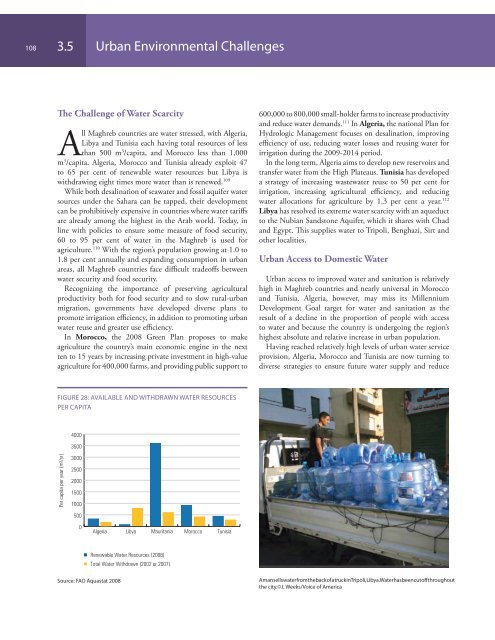The state of Arab Cities 2012/2013
The state of Arab Cities 2012/2013
The state of Arab Cities 2012/2013
Create successful ePaper yourself
Turn your PDF publications into a flip-book with our unique Google optimized e-Paper software.
108 3.5 Urban Environmental Challenges<strong>The</strong> Challenge <strong>of</strong> Water ScarcityAll Maghreb countries are water stressed, with Algeria,Libya and Tunisia each having total resources <strong>of</strong> lessthan 500 m 3 /capita, and Morocco less than 1,000m 3 /capita. Algeria, Morocco and Tunisia already exploit 47to 65 per cent <strong>of</strong> renewable water resources but Libya iswithdrawing eight times more water than is renewed. 109While both desalination <strong>of</strong> seawater and fossil aquifer watersources under the Sahara can be tapped, their developmentcan be prohibitively expensive in countries where water tariffsare already among the highest in the <strong>Arab</strong> world. Today, inline with policies to ensure some measure <strong>of</strong> food security,60 to 95 per cent <strong>of</strong> water in the Maghreb is used foragriculture. 110 With the region’s population growing at 1.0 to1.8 per cent annually and expanding consumption in urbanareas, all Maghreb countries face difficult trade<strong>of</strong>fs betweenwater security and food security.Recognizing the importance <strong>of</strong> preserving agriculturalproductivity both for food security and to slow rural-urbanmigration, governments have developed diverse plans topromote irrigation efficiency, in addition to promoting urbanwater reuse and greater use efficiency.In Morocco, the 2008 Green Plan proposes to makeagriculture the country’s main economic engine in the nextten to 15 years by increasing private investment in high-valueagriculture for 400,000 farms, and providing public support to600,000 to 800,000 small-holder farms to increase productivityand reduce water demands. 111 In Algeria, the national Plan forHydrologic Management focuses on desalination, improvingefficiency <strong>of</strong> use, reducing water losses and reusing water forirrigation during the 2009-2014 period.In the long term, Algeria aims to develop new reservoirs andtransfer water from the High Plateaus. Tunisia has developeda strategy <strong>of</strong> increasing wastewater reuse to 50 per cent forirrigation, increasing agricultural efficiency, and reducingwater allocations for agriculture by 1.3 per cent a year. 112Libya has resolved its extreme water scarcity with an aqueductto the Nubian Sandstone Aquifer, which it shares with Chadand Egypt. This supplies water to Tripoli, Benghazi, Sirt andother localities.Urban Access to Domestic WaterUrban access to improved water and sanitation is relativelyhigh in Maghreb countries and nearly universal in Moroccoand Tunisia. Algeria, however, may miss its MillenniumDevelopment Goal target for water and sanitation as theresult <strong>of</strong> a decline in the proportion <strong>of</strong> people with accessto water and because the country is undergoing the region’shighest absolute and relative increase in urban population.Having reached relatively high levels <strong>of</strong> urban water serviceprovision, Algeria, Morocco and Tunisia are now turning todiverse strategies to ensure future water supply and reduceFIGURE 28: AVAILABLE AND WITHDRAWN WATER RESOURCESPER CAPITA40003500Per capita per year (m3/yr)300025002000150010005000AlgeriaLibyaMauritaniaMoroccoTunisiaRenewable Water Resources (2008)Total Water Withdrawn (2002 or 2007)Source: FAO Aquastat 2008A man sells water from the back <strong>of</strong> a truck in Tripoli, Libya. Water has been cut <strong>of</strong>f throughoutthe city.©J. Weeks/Voice <strong>of</strong> America


